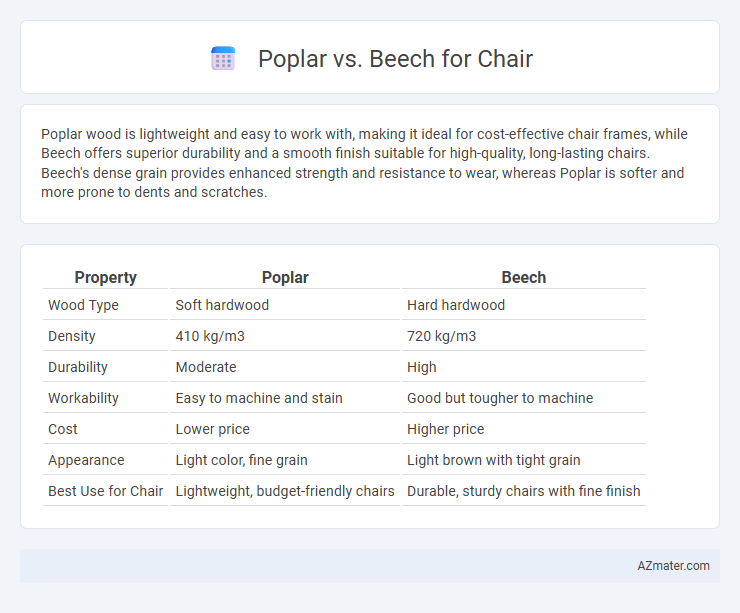Poplar wood is lightweight and easy to work with, making it ideal for cost-effective chair frames, while Beech offers superior durability and a smooth finish suitable for high-quality, long-lasting chairs. Beech's dense grain provides enhanced strength and resistance to wear, whereas Poplar is softer and more prone to dents and scratches.
Table of Comparison
| Property | Poplar | Beech |
|---|---|---|
| Wood Type | Soft hardwood | Hard hardwood |
| Density | 410 kg/m3 | 720 kg/m3 |
| Durability | Moderate | High |
| Workability | Easy to machine and stain | Good but tougher to machine |
| Cost | Lower price | Higher price |
| Appearance | Light color, fine grain | Light brown with tight grain |
| Best Use for Chair | Lightweight, budget-friendly chairs | Durable, sturdy chairs with fine finish |
Introduction to Poplar and Beech Wood
Poplar wood is a lightweight, moderately soft hardwood known for its uniform texture and pale color, making it ideal for painted furniture and intricate chair designs. Beech wood is a dense, hard hardwood characterized by its fine grain and warm, reddish-brown hue, offering excellent durability and a smooth finish for chairs requiring strong structural support. Both woods provide distinct aesthetic and functional qualities, with poplar favored for affordability and ease of use, while beech excels in strength and wear resistance.
Key Characteristics of Poplar Wood
Poplar wood features a lightweight structure and a smooth, uniform texture, making it easy to carve and shape for chair construction. It has a pale color with subtle green or yellow hues, which accepts paints and stains well, enhancing aesthetic versatility. Poplar's moderate hardness and durability provide sufficient strength for chairs intended for light to moderate use.
Key Characteristics of Beech Wood
Beech wood is prized for its durability, fine grain, and smooth texture, making it an excellent choice for chair construction. It offers high resistance to wear and impact, providing longevity and stability in furniture pieces. Its light color and uniform appearance allow for versatile staining and finishing options that enhance aesthetic appeal.
Durability Comparison: Poplar vs Beech
Beech wood exhibits superior durability compared to poplar, making it a preferred choice for chair construction where longevity and resistance to wear are critical. Poplar, being a softer hardwood with a Janka hardness rating around 540, is more prone to dents and scratches, while beech rates higher at approximately 1300, providing enhanced stability and resilience. Chairs made from beech are better suited for frequent use and heavy loads, ensuring extended structural integrity over time.
Workability and Ease of Crafting
Poplar wood offers excellent workability due to its softness and straight grain, making it easy to cut, shape, and sand when crafting chairs. Beech, while harder and denser, provides superior durability and smooth finish but requires sharper tools and more effort during carving and joinery. Both woods are favorable for chair making, but poplar excels in ease of crafting, whereas beech delivers better strength and wear resistance.
Aesthetic Appeal and Grain Differences
Poplar offers a pale, creamy color with subtle grain patterns that provide a smooth, understated look ideal for painted finishes on chairs. Beech displays a warm, reddish-brown hue with a pronounced, straight grain that enhances natural wood aesthetics and offers durability for detailed chair designs. The contrasting grain complexity and color warmth between Poplar and Beech influence the chair's overall visual appeal and style customization options.
Weight and Strength Analysis
Poplar wood is significantly lighter than beech, making it an excellent choice for chairs requiring easy mobility and handling. Beech wood offers superior strength and durability, providing better resistance to stress and wear under regular use. Selecting between poplar and beech involves balancing lightweight convenience with the enhanced structural integrity of beech for long-lasting chair construction.
Cost and Availability of Poplar and Beech
Poplar is generally more affordable and widely available compared to beech, making it a cost-effective choice for chair manufacturing. Beech, while slightly more expensive due to its durability and fine grain, is moderately available but can be pricier depending on the region. Both woods offer reliable supply chains, but poplar's abundance often results in lower overall material costs.
Environmental Impact and Sustainability
Poplar wood offers a lower environmental impact due to its fast growth rate and ability to regenerate quickly, making it a more sustainable choice for chair production compared to beech. Beech trees grow more slowly and require denser forests, which can contribute to deforestation concerns and higher carbon footprints. Choosing poplar supports sustainable forestry practices by minimizing habitat disruption and promoting responsible resource use in furniture manufacturing.
Best Applications: Choosing the Right Wood for Chairs
Poplar wood is ideal for lightweight, painted chairs due to its uniform grain and easy workability, making it suitable for crafting casual or decorative seating. Beech, with its dense, hard-wearing qualities and fine grain, excels in producing sturdy, durable chairs designed for heavy daily use and traditional styles. Selecting between poplar and beech hinges on the chair's intended function, with poplar favored for aesthetic flexibility and beech prized for longevity and strength.

Infographic: Poplar vs Beech for Chair
 azmater.com
azmater.com